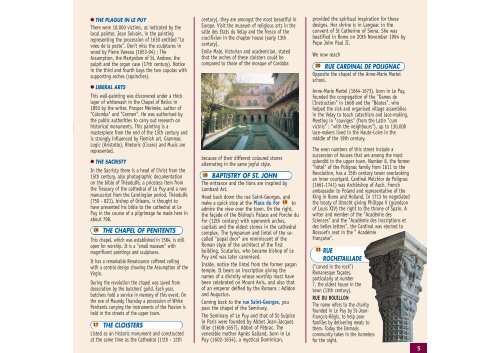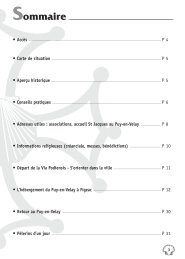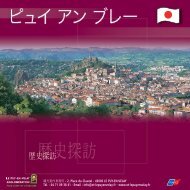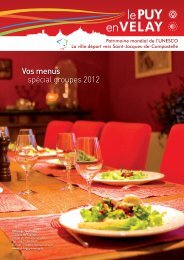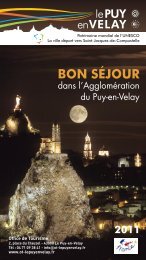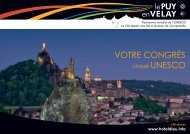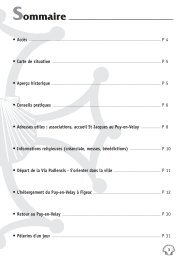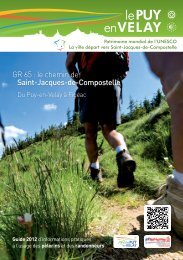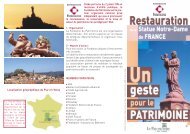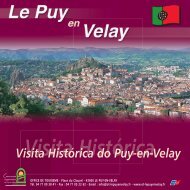Guide "Anglais":Guide "Anglais" - Le Puy-en-Velay
Guide "Anglais":Guide "Anglais" - Le Puy-en-Velay
Guide "Anglais":Guide "Anglais" - Le Puy-en-Velay
You also want an ePaper? Increase the reach of your titles
YUMPU automatically turns print PDFs into web optimized ePapers that Google loves.
● THE PLAGUE IN LE PUY<br />
There were 10,000 victims, as indicated by the<br />
local painter, Jean Solvain, in the painting<br />
repres<strong>en</strong>ting the procession of 1630 <strong>en</strong>titled "<strong>Le</strong><br />
voeu de la peste". Don't miss the sculptures in<br />
wood by Pierre Vaneau (1653-94) : The<br />
Assumption, the Martyrdom of St. Andrew, the<br />
pulpit and the organ case (17th c<strong>en</strong>tury). Notice<br />
in the third and fourth bays the two cupolas with<br />
supporting arches (squinches).<br />
● LIBERAL ARTS<br />
This wall-painting was discovered under a thick<br />
layer of whitewash in the Chapel of Relics in<br />
1850 by the writer, Prosper Mérimée, author of<br />
"Colomba" and "Carm<strong>en</strong>". He was authorised by<br />
the public authorities to carry out research on<br />
historical monum<strong>en</strong>ts. This painting is a<br />
masterpiece from the <strong>en</strong>d of the 15th c<strong>en</strong>tury and<br />
is strongly influ<strong>en</strong>ced by Flemish art. Grammar,<br />
Logic (Aristotle), Rhetoric (Cicero) and Music are<br />
repres<strong>en</strong>ted.<br />
● THE SACRISTY<br />
In the Sacristy there is a head of Christ from the<br />
15th c<strong>en</strong>tury, also photographic docum<strong>en</strong>tation<br />
on the bible of Théodulfe, a priceless item from<br />
the Treasury of the cathedral of <strong>Le</strong> <strong>Puy</strong> and a rare<br />
manuscript from the Carolingian period. Théodulfe<br />
(750 - 821), bishop of Orleans, is thought to<br />
have pres<strong>en</strong>ted his bible to the cathedral at <strong>Le</strong><br />
<strong>Puy</strong> in the course of a pilgrimage he made here in<br />
about 798.<br />
16 THE CHAPEL OF PENITENTS<br />
This chapel, which was established in 1584, is still<br />
op<strong>en</strong> for worship. It is a "small museum" with<br />
magnific<strong>en</strong>t paintings and sculptures.<br />
It has a remarkable R<strong>en</strong>aissance coffered ceiling<br />
with a c<strong>en</strong>tral design showing the Assumption of the<br />
Virgin.<br />
During the revolution the chapel was saved from<br />
desecration by the butchers' guild. Each year,<br />
butchers hold a service in memory of this ev<strong>en</strong>t. On<br />
the eve of Maundy Thursday a procession of White<br />
P<strong>en</strong>it<strong>en</strong>ts carrying the instrum<strong>en</strong>ts of the Passion is<br />
held in the streets of the upper town.<br />
17 THE CLOISTERS<br />
Listed as an historic monum<strong>en</strong>t and constructed<br />
at the same time as the Cathedral (11th - 12th<br />
c<strong>en</strong>tury), they are amongst the most beautiful in<br />
Europe. Visit the museum of religious arts in the<br />
salle des Etats du <strong>Velay</strong> and the fresco of the<br />
crucifixion in the chapter house (early 13th<br />
c<strong>en</strong>tury).<br />
Emile Male, historian and academician, stated<br />
that the arches of these cloisters could be<br />
compared to those of the mosque of Cordoba<br />
because of their differ<strong>en</strong>t coloured stones<br />
alternating in the same joyful style.<br />
18 BAPTISTRY OF ST. JOHN<br />
The <strong>en</strong>trance and the lions are inspired by<br />
Lombard Art.<br />
Head back down the rue Saint-Georges, and<br />
make a quick stop at the Place du For 19 to<br />
admire the view over the town. On the right,<br />
the façade of the Bishop's Palace and Porche du<br />
For (12th c<strong>en</strong>tury) with op<strong>en</strong>work arches,<br />
capitals and the oldest stones in the cathedral<br />
complex. The tympanum and lintel of the socalled<br />
"papal door" are reminisc<strong>en</strong>t of the<br />
Roman style of the architect of the first<br />
building, Scutarius, who became bishop of <strong>Le</strong><br />
<strong>Puy</strong> and was later canonised.<br />
Inside, notice the lintel from the former pagan<br />
temple. It bears an inscription giving the<br />
names of a divinity whose worship must have<br />
be<strong>en</strong> celebrated on Mount Anis, and also that<br />
of an emperor deified by the Romans : Adidon<br />
and Augustus.<br />
Coming back to the rue Saint-Georges, you<br />
pass the chapel of the Seminary.<br />
The Seminary of <strong>Le</strong> <strong>Puy</strong> and that of St-Sulpice<br />
in Paris were founded by Abbot Jean-Jacques<br />
Olier (1608-1657), Abbot of Pébrac. The<br />
v<strong>en</strong>erable mother Agnès Galland, born in <strong>Le</strong><br />
<strong>Puy</strong> (1602-1634), a mystical Dominican,<br />
provided the spiritual inspiration for these<br />
designs. Her shrine is in Langeac in the<br />
conv<strong>en</strong>t of St Catherine of Si<strong>en</strong>a. She was<br />
beatified in Rome on 20th November 1994 by<br />
Pope John Paul II.<br />
We now reach<br />
20 RUE CARDINAL DE POLIGNAC<br />
Opposite the chapel of the Anne-Marie Martel<br />
school.<br />
Anne-Marie Martel (1664-1673), born in <strong>Le</strong> <strong>Puy</strong>,<br />
founded the congregation of the "Dames de<br />
l'Instruction" in 1668 and the "Béates", who<br />
helped the sick and organised village assemblies<br />
in the <strong>Velay</strong> to teach catechism and lace-making.<br />
Meeting in "couviges" (from the Latin "cum<br />
vicinis" : "with the neighbours"), up to 130,000<br />
lace-makers lived in the Haute-Loire in the<br />
middle of the 19th c<strong>en</strong>tury.<br />
The ev<strong>en</strong> numbers of this street include a<br />
succession of houses that are among the most<br />
spl<strong>en</strong>did in the upper town. Number 8, the former<br />
"hôtel" of the Polignac family from 1611 to the<br />
Revolution, has a 15th c<strong>en</strong>tury tower overlooking<br />
an inner courtyard. Cardinal Melchior de Polignac<br />
(1661-1741) was Archbishop of Auch, Fr<strong>en</strong>ch<br />
ambassador to Poland and repres<strong>en</strong>tative of the<br />
King in Rome and Holland. In 1713 he negotiated<br />
the treaty of Utrecht giving Philippe V (grandson<br />
of Louis XIV) the right to the throne of Spain. A<br />
writer and member of the "Académie des<br />
Sci<strong>en</strong>ces" and the "Académie des inscriptions et<br />
des belles lettres", the Cardinal was elected to<br />
Bossuet's seat in the " Académie<br />
Française".<br />
21 RUE<br />
ROCHETAILLADE<br />
("carved in the rock")<br />
Romanesque façades,<br />
particularly at number<br />
7, the oldest house in the<br />
town (13th c<strong>en</strong>tury).<br />
RUE DU BOUILLON<br />
The name refers to the charity<br />
founded in <strong>Le</strong> <strong>Puy</strong> by St-Jean-<br />
François-Régis, to help poor<br />
families by delivering meals to<br />
them. Today the Emmaüs<br />
community takes in the homeless<br />
for the night.<br />
5


